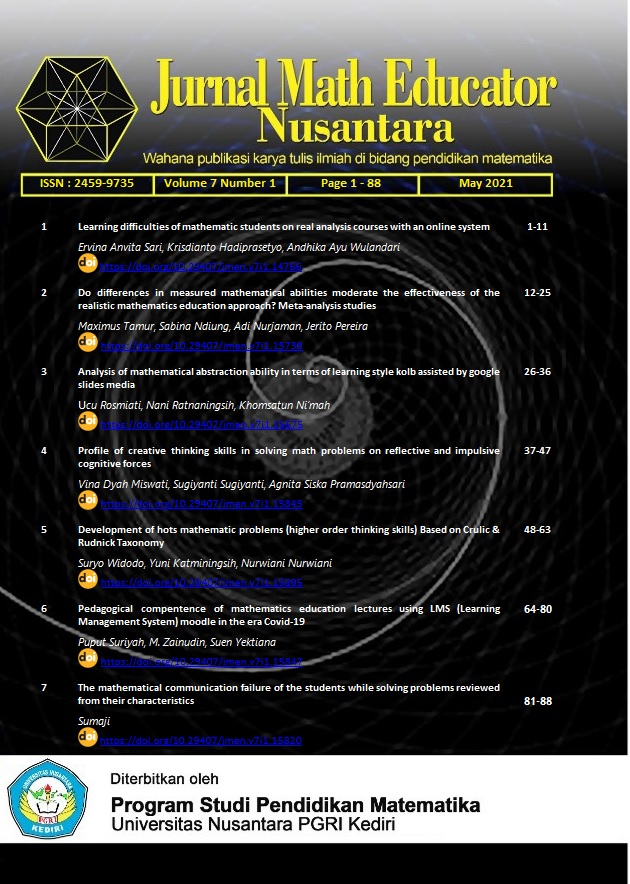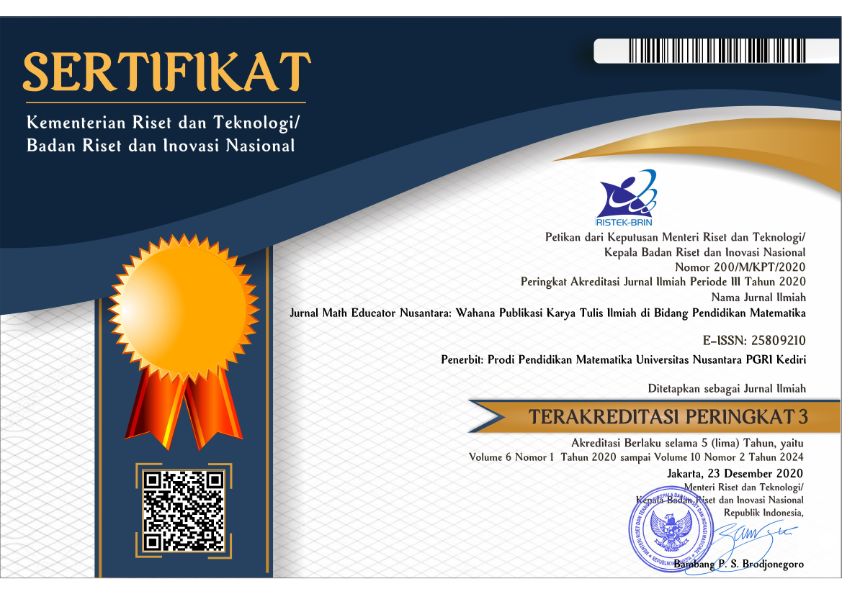Analysis of mathematical abstraction ability in terms of learning style kolb assisted by google slides media
DOI:
https://doi.org/10.29407/jmen.v7i1.15675Keywords:
Mathematical Abstraction Skills, Kolb’s Learning Style, Google SlidesAbstract
The purpose of this study was to describe students' mathematical abstraction abilities in terms of the types of learning styles diverger, accommodator, converger, and assimilator. This research is a qualitative research with research subjects namely students of class VIII SMP. Of the 16 research subjects, one subject was selected in each Kolb learning style group based onbasis purposive. The instruments used in this study were Kolb's learning style questionnaire, mathematical abstraction test questions, and interviews. Mathematical abstraction ability tests are given online viamedia google slides. Based on the data analysis, it is concluded that (1) Student with diverger learning styles can complete indicators of mathematical abstraction ability, except indicators make generalizations. (2) Student with an accommodator learning style can complete indicators of mathematical abstraction ability unless the indicator identifies the characteristics of the object being manipulated or imagined and the indicator makes generalizations. (3) Students with converger and assimilator learning styles can solve all indicators of mathematical abstraction ability.
References
Amir, M. F. (2015). Proses berpikir kritis siswa sekolah dasar dalam memecahkan masalah berbentuk soal cerita matematika berdasarkan gaya belajar. Jurnal Math Educator Nusantara: Wahana Publikasi Karya Tulis Ilmiah Di Bidang Pendidikan Matematika, 1(2). Retrieved from https://ojs.unpkediri.ac.id/index.php/matematika/article/view/235
Anwar, C. (2017). Teori-teori pendidikan. Yogyakarta: Diva Press
Ardina, F. R. (2016). LKS dan RPP model 5E pada materi teorema pythagoras untuk meningkatkan komunikasi matematis siswa kelas VIII. Jurnal Math Educator Nusantara: Wahana Publikasi Karya Tulis Ilmiah Di Bidang Pendidikan Matematika, 2(02), 137 –149. Retrieved from https://ojs.unpkediri.ac.id/index.php/matematika/article/view/226
Ghufron, M. N. & Risnawita, R. (2014). Gaya belajar (2nd ed.). Jogjakarta, Indonesia: Pustaka Pelajar
Daimaturrohmatin, D., & Rufiana, I. S. (2019). Analisis Kemampuan Komunikasi Matematis Siswa Ditinjau Dari Gaya Belajar Kolb. Edupedia, 3(1), 17. https://doi.org/10.24269/ed.v3i1.232
Fiantika, F. R., Budayasa, I. ketut, & Lukito, A. (2017). Berpikir Spasial Komponen Penting Representasi Internal Pada Berpikir Spasial: Representasi Internal: Distorsi: Abstraksi: Berpikir Spasial. Jurnal Math Educator Nusantara: Wahana Publikasi Karya Tulis Ilmiah Di Bidang Pendidikan Matematika, 3(1). https://doi.org/10.29407/jmen.v3i1.782
Fitriyani, W., & Sugiman, S. (2014). Pengembangan Perangkat Pembelajaran Teorema Pythagoras Dengan Pendekatan Ideal Berbantuan Geogebra. Jurnal Riset Pendidikan Matematika, 1(2), 269. https://doi.org/10.21831/jrpm.v1i2.2681
Handayani, E., & Ratnaningsih, N. (2019). Kemampuan Penalaran Matematik Peserta Didik Ditinjau Dari Gaya Belajar Kolb. Prosiding Seminar Nasional & Call For Papers Program Studi Magister Pendidikan Matematika. Tasikmalaya: Universitas Siliwangi, 161–167.
Khoerunnisa, S. N., Ratnaningsih, N., & Muslim, S. R. (2020). Analisis kemampuan penalaran induktif matematik peserta didik ditinjau dari gaya belajar silver dan hanson. Journal of Authentic Research on Mathematics Education (JARME), 2(1), 67–78.
Kustiani, I., & Despa, D. (2019). Persepsi Peserta Program PS PPI Unila Mengenai Aplikasi Pembelajaran Daring. Buletin Profesi Insinyur, 2(3), 122–124. https://doi.org/10.20527/bpi.v2i3.55
Manolis, C., Burns, D. J., Assudani, R., & Chinta, R. (2013). Assessing experiential learning styles: A methodological reconstruction and validation of the Kolb Learning Style Inventory. Learning and Individual Differences, 23(1), 44–52. https://doi.org/10.1016/j.lindif.2012.10.009
Nurhasanah, F., Kusumah, Y. S., & Sabandar, J. (2017). Concept of Triangle : Examples of Mathematical. International Journal on Emerging Mathematics Education, 1(1), 53–70.
Nurhikmayati, I. (2017). Kesulitan Berpikir Abstrak Matematika Siswa Dalam Pembelajaran Problem Posing Berkelompok. KALAMATIKA Jurnal Pendidikan Matematika, 2(2), 159. https://doi.org/10.22236/kalamatika.vol2no2.2017pp159-176
Ramlah, Firmansyah, D., & Zubair, H. (2014). Pengaruh Gaya Belajar Dan Keaktifan Siswa Terhadap Prestasi Belajar Matematika. Jurnal Ilmiah Solusi, 1(3), 68–75.
Rofiqoh, Z., & Kurniasih, A. W. (2016). Analisis Kemampuan Pemecahan Masalah Matematika Siswa Kelas X Dalam Pembelajaran Discovery Learning Berdasarkan Gaya Belajar Siswa. Unnes Journal of Mathematics Education, 5(1). https://doi.org/10.15294/ujme.v5i1.9344
Suwanto, F. R., Tobondo, Y. V., & Riskiningtyas, L. (2017). Kemampuan Abstraksi dalam Pemodelan Matematika. May 2017, 301–306.
Tata. (2015). Peningkatan kemampuan pemodelan dan abstraksi matematis serta motivasi belajar peserta didik sekolah menengah pertama melalui pembelajaran kontekstual kolaboratif. Disertasi, UPI(Fakultas Ilmu Pendidikan), Bandung, Indonesia.
Wiryanto. (2014). Level-level abstraksi dalam pemecahan masalah matematika Abstrak. 03(03), 569–578. https://jurnalmahasiswa.unesa.ac.id/index.php/jurnal-pendidikan-teknik-elektro/article/view/9569
Yusepa, B. (2017). Kemampuan Abstraksi Matematis Siswa Sekolah Menengah Pertama (Smp) Kls Viii. Symmetry: Pasundan Journal of Research in Mathematics Learning and Education, I. https://doi.org/10.23969/symmetry.v1i1.233
Downloads
Published
Issue
Section
License
Authors who publish with this journal agree to the following terms:
- Copyright on any article is retained by the author(s).
- The author grants the journal, the right of first publication with the work simultaneously licensed under a Creative Commons Attribution License that allows others to share the work with an acknowledgment of the work’s authorship and initial publication in this journal.
- Authors are able to enter into separate, additional contractual arrangements for the non-exclusive distribution of the journal’s published version of the work (e.g., post it to an institutional repository or publish it in a book), with an acknowledgment of its initial publication in this journal.
- Authors are permitted and encouraged to post their work online (e.g., in institutional repositories or on their website) prior to and during the submission process, as it can lead to productive exchanges, as well as earlier and greater citation of published work.
- The article and any associated published material is distributed under the Creative Commons Attribution-ShareAlike 4.0 International License
















